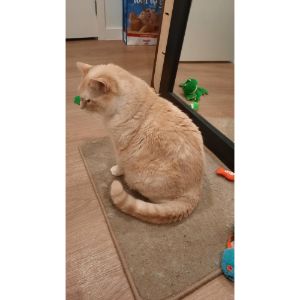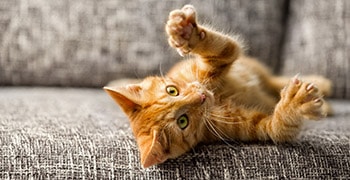
Cats are smart but stubborn. While it is not possible to gauge a cat’s intelligence based on an IQ, there are other ways to tell if a cat is smart and easy to train. The IQ of a cat might be hard to determine based on actions or behavior.
Before you scroll further down this guide, check out these other cat-related articles: How To Put Your Cat on A Diet and Can Cats Eat Ants?.
Table of Contents
What Is The IQ Of a Cat?

When determining which domestic species is smarter, the answer isn’t as evident as it appears.
Unlike human intelligence, which can be measured using an IQ test, an animal’s intelligence cannot be labeled with a black-or-white answer.
Human intelligence can also be compared to that of other animals, but animal-to-animal comparisons can be more complicated. Cat intelligence has been studied in some studies.
Scientists are learning that if they examine the cognitive abilities of cats in various cognitive tasks, such as recognizing objects, navigating spaces, and solving problems, they can better understand their intelligence.
It was determined that cats have an intelligence level comparable to that of dogs and other mammals in the study.
A fascinating finding of the study is that the intelligence of cats correlates with their social status among family and community members.
A higher score on cognitive tests was achieved by cats adopted or raised by humans compared to those raised by other cats.
How Smart Are Cats?

In recent studies, cats have been proven capable of solving complex problems, understanding basic arithmetic, and even using tools.
A dog can remember specific people and places for years at a time, and they also have incredible memories.
Exactly what is it about cats that makes them so intelligent? They’re also known to adapt well to new environments due to their natural curiosity.
Felines have a brain that makes up 0.9% of their body weight, compared to dogs and people with brains that contribute 1.2% and 2%, respectively.
Their brains, however, are structurally complex as ours, almost to the same extent as ours.
Many studies have measured the number of neurons in cats’ brains, which is often cited as an example of this. It is estimated that cats have about 250 million neurons in their cerebral cortexes – which is quite a bit of brain power.
Humans have 16 billion neurons, whereas dogs have 400-600 million neurons. Despite their smaller size, cats are still more intelligent than their canine companions.
There are times when cats are smarter than dogs, as demonstrated by the following evidence.
The location of a bowl of food could be remembered for up to 16 hours in a behavioral experiment. The maximum time a dog could spend on the ground was five minutes.
In addition to being persistent, cats tend to hold grudges when they don’t get what they want. As well as our ability to sense non-verbal cues, humans are also capable of predicting what other people are thinking and feeling.
Some studies have demonstrated that cats can respond to cues like pointing from humans.
Senior cats often have honed this skill with time, which is why they know when to snuggle with you (you’re calm on the couch) and when to leave you alone (you’re frustrated). Even though cats are smart, they don’t respond to social rewards like dogs.
Furthermore, cats are less determined and more easily frustrated than canines. Basically, cats can’t be trusted to always follow instructions (and they are stubborn to boot).
Which Cat Breeds Are The Smartest?

Most cat breeds are intelligent, but some are known for being smarter than others.
Abyssinian
Athletic, agile, and affectionate, this sleek-looking cat is easy to handle and get along with.
There is a high level of intelligence in Abyssinians, and they are very aware of their families’ activities. Breeds like this enjoy heights, perched above the room, watching everything.
A feline agility course is one of the most enjoyable things for this cat type because it learns tricks quickly. Most enjoy being petted or brushed, although they are generally not lap cats.
Their ability to adapt well to most living conditions is another quality that makes them great companions for other animals.
Balinese

Longhaired Siamese cats, called Balinese, are descendants of the Siamese. Their curiosity makes them very active cats who are always keen to learn about what their humans are doing.
Furthermore, they are chatty cats who often voice their opinions.
Make this cat’s life active by providing puzzles or teaser toys, as well as a cat tree for climbing. Dogs of this breed are intelligent, can fetch, walk on a leash, and learn tricks quickly.
When left unstimulated for too long, they can get into mischief exploring their home. They’re typically affectionate with their families but can become mischievous if left unattended for too long.
Savannah Cat
African servals and domestic cats are crossed to produce the Savannah cat. Savannahs are among the largest domestic breeds; their height has been documented by the Guinness Book of World Records as the tallest cat in the world.
There is a tremendous amount of intelligence and curiosity in Savannah cats. Their mischievous nature comes from being able to be taught tricks and bored.
There are three types of Savannah cats: high-energy, medium-energy, and low-energy. They need to be accompanied, have puzzle toys, and have a lot of room to play.
Bengal

Perhaps one of the most distinctive features of a Bengal is its exotic coat resembling that of a jaguar or leopard. In this breed, domestic cats are crossed with Asian leopard cats.
They are highly intelligent, and athletic and still have a wild side. Their favorite activity is running, jumping, climbing, and playing.
The dogs need plenty of space in which to exercise (especially vertical space) as well as mental challenges, such as puzzles, toys, and games.
There is almost no difference between its fingers and paws regarding nimbleness.
A few of them can switch on and off lights, pluck out small items from drawers, and turn on and off aquariums.
Siamese
The Siamese cats have been domesticated since ancient times and originated in Thailand.
Originally, Siam was the name of Thailand, and the word Siamese refers to it. Socialization and chattiness are two of the most common characteristics of the Siamese cat.
A child’s natural curiosity and instinct to stimulate their minds make them prone to trouble because of their inquisitiveness.
They are affectionate and affectionate, but they can destroy things around the house when they are restless.
Havana Brown

The Havana Brown has a silky, chocolaty coat, making him a beautiful cat. Cats of this breed are relatively rare and result from crossbreeds among the Siamese and several other breeds.
Cats with this personality type are usually intelligent, curious, and talkative, and they love socializing with their families. It is moderately energetic, and they prefer mental and physical challenges such as puzzles and teasers.
Cornish Rex
Cornwall in the United Kingdom is home to the Cornish Rex. An accidental genetic mutation on a farm in the 1950s created this breed. A Cornish Rex cat’s curly hair and large ears give this cat an elflike appearance.
Cornish Rex cats are friendly, playful, loyal, laid-back, and easygoing. Running, jumping, and climbing are some of their favorite physical activities.
Can Cats Be Trained?

Research has shown that cats can solve complex problems, comprehend basic arithmetic, and use tools.
In addition to having incredible memories, they can recall specific people and places for years. What makes cats so smart? Their ability to adapt to new environments and their curiosity contribute to their intelligence.
As a result of your own training, you’ve already made your cat more intelligent, studies suggest.
Considering your cat is in tune with your daily schedule, it probably knows when you’re in the mood to play and cuddle and when it’s time to eat. Food or attention are the rewards, which motivate her to show up.
Are Cats Smarter Than Dogs?

Different opinions are depending on who you ask. The domestication of dogs is far older than that of cats, they are more practical and social than cats, but that doesn’t mean cats aren’t intelligent.
Because cats are so challenging to study, it’s impossible to be specific.
Tips For Training a Cat

Cats are fairly easy to train, despite their being stubborn. You can do a few things to help make training a cat easier. Here are a few of them.
Use A Clicker
When you’re learning how to train a cat, a clicker will be useful for giving positive reinforcement. They’re very inexpensive and can be used for various animals.
Normally, cats are trained by rewarding them with treats following clicks, though you can also use a regular pen with a clicky button.
You can use the same tactics when giving your cat a pill. You can improve your cat’s chances of catching on if you use a clicker:
If it follows a command, hears the click, and then gets a treat, it’s likely to understand why it’s being rewarded. Use these tips to avoid being scratched by your cat.
Targeting

You can reward your cat for touching its nose or head by touching your finger or a target stick. In some instances, the sound of a clicker helps reinforce targeting.
Using targeting, you can cue your cat to target on the exam table while at the vet’s office.
Stationing
By cueing your cat to visit a certain spot, you are similar to targeting. The cat must come to a specific mat, blanket, carrier, etc., rather than pressing their nose on a target.
Stationing is reinforced through a clicker, just as it is with targeting.
It is also practical when you need to medicate your cat, so your cat sits or stands where medication can be administered easily.
The device can also be used to soothe your cat if it is overstimulated by guests who are over.
Capturing

This training method is a little more advanced than targeting and stationing.
By reinforcing a behavior when your cat performs it on their own accord instead of giving it any cues, you are not targeting or stationing your cat.
It is possible to capture various behaviors, one of which is getting into the carrier by clicking them first to show interest, then holding the click progressively throughout the process.
You can reward your cat by letting them put their heads or paws in the carrier once they discover it’s rewarding.
After two paws start to happen easily, try for three. Your cat will enter the carrier as soon as you increase what you will click for.
Frequently Asked Questions
Are black cats smarter?
Black cats might be intelligent, but this varies from cat to cat.
What is smarter a pig or a cat?
Studies have shown that a pig is smarter than a cat.
Do cats have personality?
The short answer is yes. The long answer is cats have a wide cornucopia of traits that distinguish them from other cats.
If you find this guide, “What Is The IQ Of A Cat,” informative and helpful, you can check out these other cat-related articles from our team:
- Is Rosemary Oil Safe for Cats?
- Do Cats Scratch Leather?
- My Cat is in Heat and Won’t Shut Up – What Should I Do?
You can learn more about this topic by watching “I IQ Tested My Cats” down below:




